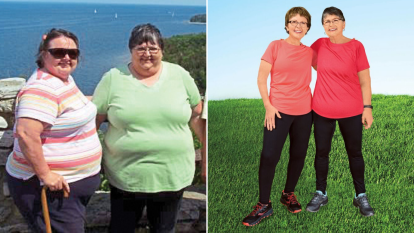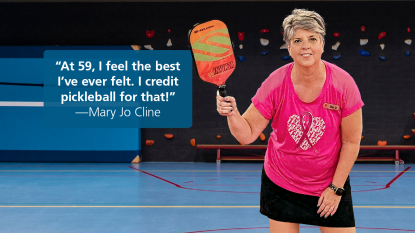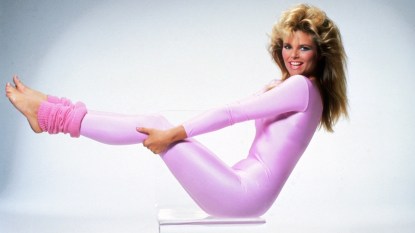7 Best Back Workouts for Women
A strong back equals good posture and a toned figure.

Here’s a secret: A “slim” figure doesn’t necessarily mean a whittled waist. Well-defined back muscles, honed through back exercises, can contribute to the appearance of a leaner waistline, and women with stronger backs and wider lats will often be perceived as thinner than they actually are. It’s a neat trick — this playing with proportion to create a trimmer and more balanced physique — especially if you’re post-menopausal and struggle with stubborn belly fat.
There are additional benefits, too: Strengthening the upper body with good back exercises reduces the dreaded back fat that causes bulges around the edges of the bra and creates that weird V-shaped roll down the sides of the back when you twist. Strengthening the lower back helps to avoid this, to say nothing of the practical advantages of having a strong back, which include maintaining an upright posture and safeguarding against injuries. Simply put, for a well-rounded physique and effective back support, it’s important to train the muscles that can’t be seen in the mirror, like those that are in the back.
Here are some of the best back exercises for women over 50. They can be incorporated into any workout routine, and most can be performed with nothing more than a set of dumbbells. So grab your water, warm up, and let’s get started with our list of the best back exercises for women.
Scapular Pushups
When you can’t quite manage a full pushup, scapular pushups are a bodyweight exercise that (literally) has your back. This is great for folks of all fitness levels. Plus, it’s a great way to warm up back muscles — and several other muscle groups, like your arms — before you start your workout session.
How-to: Begin by assuming a high plank position with a flat back while engaging your abs and glute muscles. Your arms should be at your sides with your palms flat on the ground, positioned directly under your shoulders. This is the starting position. When you’re ready, imagine a pen between your shoulder blades as you squeeze them together. Drop your torso by an inch or two while trying to compress and extend your shoulder blades. Remain in the high plank position for approximately five seconds, and then drop back down.
Upright Rows
Compound exercises — such as the upright row — are one of the most effective ways to build muscle throughout your body and improve your range of motion. These slow and controlled movements use the largest muscle groups in your body to substantially increase strength. In other words, if you want a stronger, sleeker back, add dumbbell rows to your fitness routine. This exercise works your deltoids, trapezius, rhomboids, and biceps in one fell swoop.
How-to: Standing tall with feet hip-width apart and palms facing in, grasp a kettlebell (or dumbbell). Lift the kettlebell to your chin with elbows leading the way while maintaining a tight core and a tall chest. Be sure to keep the bar close to your body. Pause at the top of the lift before inhaling as you lower the kettlebell and go back to square one. If you’re looking for an alternative beginner exercise, try bent-over rows or renegade rows, both of which are easy to add to your back workout plan.
Resistance Band Pull-Apart
The resistance band pull-apart is a straightforward yet efficient way to begin a back training routine. Scapular retraction — or bringing the shoulder blades together — is the primary motion of this workout. The rhomboids, rear deltoids, and trapezius, which are located in the upper back, get some much-needed attention this way. Retraction exercises, such as this one, are beneficial to shoulder health because they help with scapular stabilization.
How-to: Raise your arms and stand tall. Keep a resistance band stretched out in front of you, parallel to the floor. (You can even try this with the band looped around a solid object for resistance.) Pull the band to your chest by extending your hands and arms laterally away from your shoulders while maintaining a straight arm position. Keep the band at about chest height throughout the movement, and return your hands to the start position when they’ve reached their full extent.
Lat Pulldown
The lat pulldown is a fantastic foundational exercise to strengthen the latissimus dorsi muscle — aka the broadest muscle in your back — which supports good posture and spinal stability. Although it can be done with a resistance band, it’s most commonly performed at a workstation with adjustable resistance, usually weight plates.
How-to: Sit comfortably on the pulldown seat with both feet flat on the floor. Grasp the bar with a wide, overhand, knuckles-up grip. Pull the bar down until it’s roughly level with your chin. Exhale on the downward motion. While sitting slightly backward is perfectly fine, try your best to keep your upper torso stationary. The movements ends when your elbows cannot move any further down. Pause for a moment or two before slowly returning the bar to the starting position while controlling its gradual ascent.
Good Morning
This strangely-named exercise earned its moniker because, when executing it properly, one looks as if they’re bowing to say “good morning.” It starts with a barbell across the upper back. From there, bend your hips (similar to a back squat) so that your torso ends nearly parallel to the ground. It looks like a squat gone wrong, but the truth is that the good morning is one of the best exercises you can do to develop your glutes, hamstrings, and mid-back muscles (a.k.a. the erector spinae). Good mornings can also be used as a mobility exercise to enhance range of motion in the hips, making them a multifunctional asset to your full-body routine.
How-to: Begin with your feet shoulder-width apart, knees slightly bent, and a light dumbbell in each hand. Stack the weights on your shoulders, with one end at the base of your neck and the other end toward your shoulder blade. Keeping your ab muscles engaged and spine in a tall, neutral position, hinge at your hips, bringing your torso nearly parallel to the ground. Return to start — that’s one rep.
Superman
The superman is an excellent back exercise that gets your abdominal muscles involved in developing a taut, well-defined back.
How-to: Lying face down, extend your left and right arms straight in front of you, and your left and right legs directly behind you in a straight line. Put your forehead flat to the floor. Simultaneously lift your head, arms, and legs off the ground at a slight bend. At the top of the movement, hold for a few seconds before slowly lowering your head, arms, and legs back down. That’s one rep. Want to make this exercise more of a challenge? Try holding a dumbbell or medicine ball.
Barbell Deadlift
The barbell deadlift is a fantastic full-body workout. Why? Because it targets both the upper and lower body — including your back muscles.
How-to: Keep your feet shoulder-width apart and your back straight as you stand behind a barbell. With your chest held high, flex at the hips and slowly descend your knees to reach down and grab the barbell. Hold the bar with an overhand grip, just beyond shoulder width. Maintaining a flat stance, pull your torso up and thrust your hips forward, rolling the barbell against your shins as you pull up. Keep the bar as close to your body as possible. Lower the bar back down to the flood. That’s one rep.
The Final Word
A strong, defined back is more than mere aesthetics. As one of the most essential parts of the human body — and often the most neglected — your back contributes to everything from maintaining good posture to supporting mobility. In other words, your back muscles are very important.
Check with your doctor or healthcare provider before you pursue any new fitness routine. But once you get the green light, go forth and carry your muscles and bones to a stronger, healthier you.













